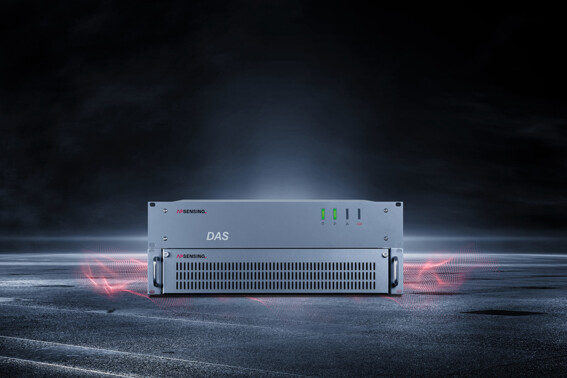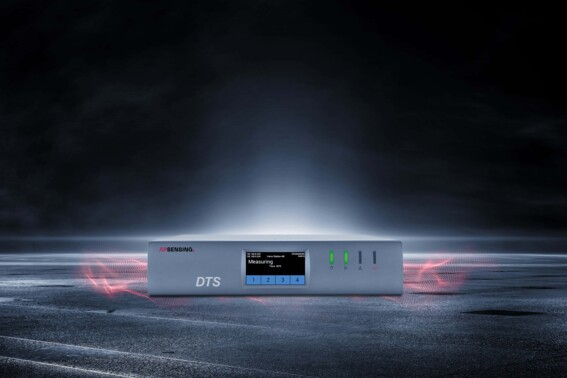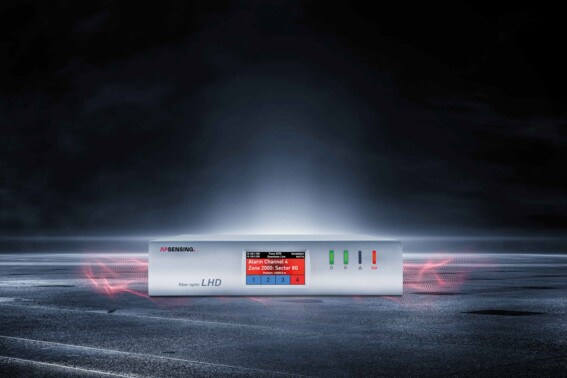Distributed Fiber Optic Sensing (DFOS) systems provide critical asset monitoring by utilizing standard fiber optic cables as sensors. These systems enable precise measurement of temperature, strain, and acoustic signals along the entire length of an optical fiber. DFOS technology plays a crucial role for the monitoring of industrial systems, critical infrastructure, and scientific applications.
How DFOS Works
DFOS technology leverages the intrinsic scattering properties of light in optical fibers. By launching laser pulses into the fiber, a portion of the light is scattered back due to its interaction with the glass structure. The backscattered light is analyzed through its physical properties to extract valuable data regarding environmental conditions along the length of the fiber. Based on the chosen DFOS technology, this process enables the creation of a continuous spatial profile of temperature, strain, or acoustic activity over time.
Types of Scattering Used in DFOS
DFOS technology is based on different types of optical scattering phenomena:
- Raman Scattering: Used in Distributed Temperature Sensing (DTS) and Linear Heat Detecion (LHD) to measure accurate temperature variations along the fiber over time.
- Brillouin Scattering: Enables temperature measurements in Distributed Temperature Sensing (DTS)
over long distances along an optical fiber.
In Distributed Temperature and Strain Sensing (DTSS) , it allows for the simultaneous and independent measurement of both temperature and mechanical strain. - Rayleigh Scattering: The foundation of Distributed Acoustic Sensing (DAS) , which captures vibrations and acoustic signals for security and structural monitoring.
Monitoring Capabilities of DFOS
DFOS systems enable high spatial resolution, real-time monitoring over extensive distances, offering valuable insights across various industries. Key capabilities include:
- Distributed Acoustic Sensing (DAS) repurposes optical fibers into a dense network of acoustic sensors, capturing vibrations and acoustic signals in real time, benefiting security, transportation, and seismic monitoring applications.
- Distributed Temperature Sensing (DTS) utilizes fiber optic technology to deliver continuous temperature measurements along the entire fiber length, ensuring precise thermal profiling for industrial applications.
- Linear Heat Detection (LHD) uses fiber optic sensing cables to detect temperature changes along their length, providing fast, reliable and cost-effective fire and overheating detection for industrial, commercial, and critical infrastructure applications.
- Distributed Temperature & Strain Sensing (DTSS) extends the functionality of DTS by simultaneously detecting both temperature changes and mechanical strain, making it essential for structural integrity assessments and infrastructure monitoring.
Benefits & Advantages of Distributed Fiber Optic Sensing
- Continuous, Distributed Measurements: Provides a complete spatial profile rather than point-based data.
- High Sensitivity and Accuracy: Detects minor variations in temperature, strain, or acoustic signals.
- Immunity to Electromagnetic Interference: Ideal for deployment in harsh industrial environments.
- Cost-Effective & Low Maintenance: Glass fibers are durable and have long-term stability. Using existing fiber optic infrastructure reduces installation and maintenance costs.
- Scalability: Monitors assets over distances of up to 100 km or more without the need for additional sensors.
- Resistant to Harsh Environments: Fiber cables can operate in extreme temperatures, corrosive, or high-pressure environments.
AP Sensing's DAS System
DAS N51/N52-Series
Enhanced performance and measurement capabilities for protecting your valuable assets and infrastructure. Our fifth generation DAS features a world-leading measurement range for true phase-based systems without requiring additional amplification. It provides improved measurement performance with enhanced usability and reduced signal artifacts such as fading.
AP Sensing's DTS Systems
DTS N45-Series
AP Sensing covers all market requirements with its systems. Our DTS N45-Series is designed to operate anywhere – from the desert to the arctic. With the industry’s most complete set of certifications and stringent type tests, highest product quality and a long product life is guaranteed.
AP Sensing's LHD System
LHD N45-Series
With the third generation of our LHD system, the N45-Series, AP Sensing is raising the standard for fiber optic LHD. The N45-Series is certified to national and international standards for fire detection, offering the longest certified range on the market. No other fire detection system can withstand temperatures up to 750 °C (1400 °F) without losing monitoring capabilities.
With a proven track record and continued innovation, AP Sensing offers a completely integrated, end-to-end solution made in Germany. Our team works together with you to select the right combination of technologies to fit your requirements.
Key Takeaways
Distributed Fiber Optic Sensing (DFOS) technology is transforming the monitoring of industrial systems, critical infrastructure, and scientific applications—enabling smarter, safer, and more efficient operations.
DFOS leverages standard fiber optic cables to continuously measure temperature, strain, or acoustic signals along an entire asset. Advanced data processing algorithms interpret these signals to detect anomalies, structural changes, or environmental conditions, enabling early fault detection, predictive maintenance, and improved operational efficiency. With its ability to cover vast distances, provide high spatial resolution, and deliver real-time insights, DFOS empowers operators to enhance safety, optimize performance, and respond proactively to potential issues.






